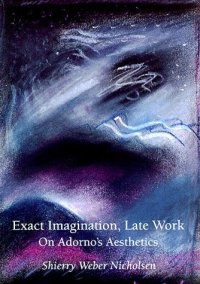
Ebook: Exact Imagination, Late Work: On Adorno's Aesthetics
Author: Shierry Weber Nicholsen
- Series: Studies in Contemporary German Social Thought
- Year: 1997
- Publisher: The MIT Press
- Edition: 1
- Language: English
- pdf
In Exact Imagination, Late Work, Shierry Weber Nicholsen begins the process of appropriating Adorno through the centrality of the aesthetic dimension.
Until now, most English-language writing on Adorno has attempted to place him in various contexts and to differentiate him from other thinkers. Such work, while important, masks our failure to imaginatively appropriate Adorno's ideas. In Exact Imagination, Late Work, Shierry Weber Nicholsen begins the process of appropriation through the centrality of the aesthetic dimension.
Adorno uses the term "exact imagination" to describe nondiscursive rationality. Exact imagination, which is the opposite of creative imagination, marks the conjunction of knowledge, subjective experience, and aesthetic form. Unlike exact imagination, "late work" is characterized by the disjunction of subjectivity and objectivity.
Exact imagination and late work mark the bounds of Nicholsen's exploration. The five interlocked essays, based on material from Adorno's "aesthetic writings," take up such issues as subjective aesthetic experience, the historicity of artworks and our experience of them, Adorno's conception of language, the nature of configurational or constellational form in Adorno's work, and the relation between the artwork, aesthetic experience, and philosophy. A subtext is the unraveling of Adorno's use of the ideas of his colleague Walter Benjamin. Nicholsen's essays themselves can be perceived as a constellation of their own around the central issue of the inseparability of form in its aesthetic dimension and nondiscursive rationality.
Until now, most English-language writing on Adorno has attempted to place him in various contexts and to differentiate him from other thinkers. Such work, while important, masks our failure to imaginatively appropriate Adorno's ideas. In Exact Imagination, Late Work, Shierry Weber Nicholsen begins the process of appropriation through the centrality of the aesthetic dimension.
Adorno uses the term "exact imagination" to describe nondiscursive rationality. Exact imagination, which is the opposite of creative imagination, marks the conjunction of knowledge, subjective experience, and aesthetic form. Unlike exact imagination, "late work" is characterized by the disjunction of subjectivity and objectivity.
Exact imagination and late work mark the bounds of Nicholsen's exploration. The five interlocked essays, based on material from Adorno's "aesthetic writings," take up such issues as subjective aesthetic experience, the historicity of artworks and our experience of them, Adorno's conception of language, the nature of configurational or constellational form in Adorno's work, and the relation between the artwork, aesthetic experience, and philosophy. A subtext is the unraveling of Adorno's use of the ideas of his colleague Walter Benjamin. Nicholsen's essays themselves can be perceived as a constellation of their own around the central issue of the inseparability of form in its aesthetic dimension and nondiscursive rationality.
Download the book Exact Imagination, Late Work: On Adorno's Aesthetics for free or read online
Continue reading on any device:

Last viewed books
Related books
{related-news}
Comments (0)